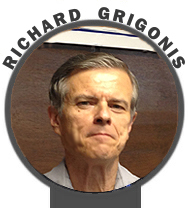Past Entry of Zippy's Telecom Blog
More Previous Columns
March 3 , 2011
Who Really Invented the Telephone? Part 3 — Elisha Gray (1835-1901)
In the days ahead we will examine in succession a several people, each of whom performed an important role in the birth of the telephone. After an introduction to the series, the first person we examined was German inventor, Johann Philipp Reis. See:
Who Really Invented the Telephone? Part 1 — Johann Philipp Reis (1834–1874) and
Who Really Invented the Telephone? Part 2 — Innocenzo Manzetti (1826-1877)
Next in this series is another remarkable electrical engineer and inventor, the man who may have literally invented Bell's telephone, Elisha Gray (August 2, 1835 – January 21, 1901).
Our next victim of history is famous for supposedly arriving at the U.S. Patent Office “two hours” after Alexander Graham Bell’s associates delivered Bell’s patent application. There is much more to the Gray-Bell controversy, but it’s too complex to discuss here in its entirety (although Yours Truly will make a go of in this column/blog). One should read A. Edward Evenson’s brilliantly researched book, The Telephone Patent Conspiracy of 1876: The Elisha Gray-Alexander Bell Controversy and Its Many Players (Jefferson, North Carolina: McFarland & Company, Inc., 2000) to get the full details. Also, see Seth Shulman's book, The Telephone Gambit: Chasing Alexander Graham Bell's Secret
(New York: W. W. Norton & Company, 2008).
Still, if one wades through the vast morass of this saga, one can extract some pertinent facts and arrange them chronologically in a numbered outline, as follows:
1. In 1870, Gray buys out former telegraphist Enos M. Barton’s first partner (George Shawk) in a small burglar and fire alarm company and together they form the partnership of Gray and Barton. The operation soon moves from Cleveland, Ohio to Chicago, Illinois, and in 1872 a one-third interest is taken in the company by the Western Union Telegraph Company. The name Gray and Barton is changed to the Western Electric Manufacturing Company. Among other things, it supplies telegraphic equipment to Western Union.
2. In the early to mid-1870s Both Gray and Bell were initially working on “harmonic telegraphs” able to send several telegraphic signals over the same line simultaneously in either direction. Edison had already patented a simple multiplex telegraph in 1870, and in 1875 Émile Baudot of France increased the transmission speed by a factor of four via a difficult-to-use multiplexing system. Even so, it was thought that 30 or 40 simultaneous signals could be made to occupy the same telegraph line. So important was this idea that Western Union had set up a $1 million prize to anyone who could multiply the capacity of the telegraph network.
3. While Bell attempts to interest Western Union President William Orton in his as yet unfinished telegraphic invention, Orton speaks favorably of the “ingenious workman” Elisa Gray and infuriates Bell when he tells him that his equipment is crude in comparison.
4. Bell’s patent attorneys, Anthony Pollok and Marcellus Bailey are on good terms with Zenas Fisk Wilber, the patent examiner in charge of telegraph-related inventions (Wilber served with Bailey during the Civil War). Wilber, a cousin of U.S. President Rutherford B. Hayes, is too fond of whiskey—during one year alone Washington, D.C. police receive 20 complaints concerning his drunken, disorderly behavior—and he freely borrows money from Bailey (Wilber later worked for Thomas Edison and was fired after he “borrowed” $1,300 from an account meant to pay for Edison’s patent fees).
5. Bell’s attorney Pollock drafts not one but three different patent applications for Bell, one of which is designed to “collide” with Gray’s claims, which means that Patent Examiner Wilber will have to declare an “interference” which could tie up Gray in litigation for months or years. The other application just happens to interfere with another one filed by a Danish electrician named Herr Paul la Cour.
6. By mid-1875, Bell becomes sidetracked when he finds he can transmit sound. The harmonic telegraph was based on multiple steel armatures or “reeds” of different specific lengths at each end of a line. The reeds vibrated at specific frequencies in sympathy with each other, establishing separate channels. One day (June 2, 1875) when Watson tests a reed by plucking it, another reed in a receiver vibrates even though the battery current is switched off. Bell realizes that there is enough residual magnetism in the iron cores of the transmitter/receivers so that manually vibrating one reed will set up an alternating current (or “undulating current” as they called it in those days) that vibrates another reed in another device at a distance. Furthermore, Bell presses his ear against one reed and is amazed that he can hear faint sounds of the other reeds being plucked by Watson in another room. Bell now understands that a single reed relay can receive complex sounds. Elisha Gray later claimed he discovered a similar phenomenon back in 1867, but unlike Bell, Gray never documented his sources.
7. The serendipitous affair with the metal reeds leads to Bell’s first attempt at making a telephone transmitter—the “gallows model,” a voice-powered, magneto-inductive telephone. Essentially, it’s one of his reed relays attached to a diaphragm or membrane with a speaking cavity over it. Speaking into the cavity causes the membrane to vibrate and these vibrations are translated into an electrical current by the dampened reed, and that would be sent to a similar device on the other end of a wire. It should have worked, but Bell’s magnets were too powerful, thus suppressing the diaphragm’s ability to vibrate. A second slightly improved model does transmit some faint “vocal sounds” but not articulate speech.
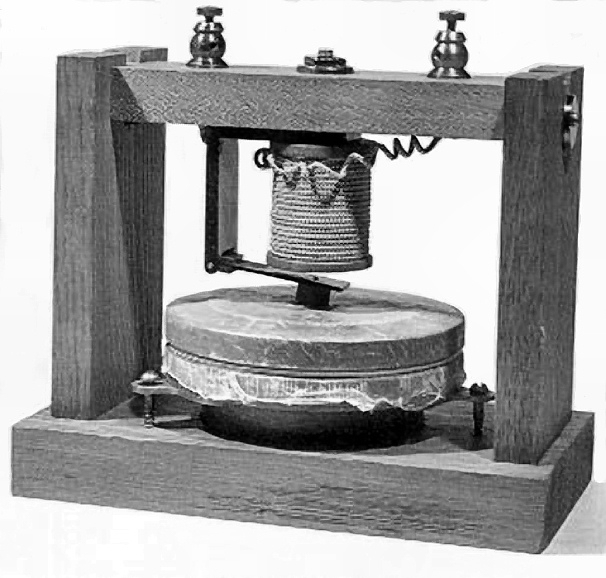
Fig. 1. Bell’s first crude attempt at inventing a telephone, the “gallows” model (seen at right). It could send and receive only some faint vocal sounds. A metal diaphragm is mounted on a skin stretched over the bowl-shaped structure at the bottom. Above this is suspended the coil in which electrical signals are induced.
8. Bell finishes drafting a new harmonic telegraph patent application in January 1876. Almost as an afterthought, he includes an illustration of the gallows telephone developed six months before. This worries Bell’s patent attorneys, since patent law prohibits two inventions to be filed under the same patent (a “double patent”). Nevertheless, the crude telephonic device will be included in Bell’s next patent, the famous Telephone Patent of March 7, 1876.
9. On January 25, 1876, Bell, his future father-in-law Gardiner Greene Hubbard, and attorney Pollok meet in New York with George Brown, a Bell family friend who was the former premier of Canada and editor of the Toronto Globe. Brown has agreed to sail to England the next day to show Bell’s harmonic telegraph plans to scientist Sir William Thomson (known later as Lord Kelvin) and to secure a patent with the British Patent Office. For his part, Brown was to receive a financial interest in the invention. Timing was everything—the British Patent Office demanded that an invention not be disclosed prior to filing, so Brown was to file in England, then send a trans-oceanic telegram to Bell signaling that the American version of the patent application could now be filed in Washington. Brown arrives in London on the weekend of February 5, 1876.
10. On Friday, February 11th, Gray, previously working on a telephone in relative secrecy, now decides to let the cat out of the bag and intends to file a caveat at the U.S. Patent Office on Monday, February 14th (Valentine’s Day). He gives his assistant, William Goodridge, a rough drawing and some pages of text describing the invention, with instructions that the caveat drawings should be finalized by William Skinkle, an employee of Gray’s attorney, William D. Baldwin (Gray and Baldwin would end their relationship acrimoniously years later; Gray would discover that Baldwin, while representing Gray against the Bell Telephone Company, had actually been on Bell’s payroll. Intriguingly, Baldwin’s last bill for his legal services was angrily rejected by Gray, and Baldwin never demanded payment).
11. Something suddenly motivates Bell’s group to violate their agreement with Brown. They rush forward and file with the U.S. Patent office before Noon on Monday, February 14th, without hearing from Brown or demanding a progress report from him.
12. Patent law at the time (the Patent Act of 1836), stipulates that an “interference” can occur only if Gray files his caveat before Bell files his patent application. Both Bell’s and Gray’s applications are hand-delivered before Noon; both sets of paperwork should have sat in an “In” basket until 3 P.M., after which they would have been sent to the chief clerk’s office, logged into a “cash blotter” (a non-chronological accounting book listing each applicant’s name along with the filing fee), and forwarded to a patent examiner the next day.
13. Strangely, the person who hand-delivers Bell’s patent application (not Bell, who was in Boston at the time) demands that the paperwork immediately be given to the Telegraphic Patent Examiner Zenas Wilber in Room 118. An obliging clerk does just that (violating standard procedure), briefly pausing en route to enter Bell’s application in the cash blotter, making it the fifth entry for that day. Gray’s caveat paperwork, still sitting in the basket, proceeds through normal, slower, channels and becomes the 39th entry in the blotter. Thus is born the popular myth—encouraged by Bell’s attorneys—that Bell’s patent application was filed “two hours” before Gray’s caveat (in some versions of the story it’s four hours).
14. During the week that follows, Patent Examiner Zenas Wilber examines both sets of paperwork. He sees that claims 1, 4 and 5 of Bell’s application might interfere with Gray’s caveat, and, in accordance with standard procedure, sends a letter to Bell and his attorneys that says he is suspending Bell’s patent for 90 days. Gray should now have had 90 days to file a full patent application, whereupon the examiner would then determine with finality whether an interference condition actually existed.
15. Bell’s attorneys then send a letter to Ellis Spear, acting commissioner of patents, containing the following:
We have inquired the date of filing of this caveat (inasmuch as we are entitled to this knowledge) and find it to be February 14, 1876—the same day on which our application was filed. If our application was filed earlier in the day than was the caveat, then there is no warrant for the action taken by the Office.
We suggest that an examination of the books in the Examiner’s Mr. Moore’s [a clerk] and the Chief Clerk’s rooms, be made with a view of determining this question.
16. But Bell’s attorneys were not “entitled to this knowledge” (the interfering caveat could have arrived up to a year prior to Bell’s application) and Wilber’s letter to them does not indicate that the caveat was Gray’s. Bell’s attorneys somehow already know that Bell’s entry in the cash blotter was ahead of Gray’s. Naturally, Bell’s attorneys are already directing attention to “the books” to decide the matter. But standard Patent Office procedure insists that only the date and not the time of filing is significant, except in exceptional circumstances. Nevertheless, on the fateful day of February 25, 1976, Ellis Spear, for reasons still unknown, violates the standard procedures he has followed for years and directs Wilber to lift the suspension on Bell’s application. In all the tumultuous and litigious years that follow, Spear is never asked why he revocated the suspension of Bell’s patent.
17. Amazingly, Bell and his associates must still surmount more difficulties. Wilber finds another, earlier caveat from Gray, filed on January 27th, that can definitely interfere with Bell’s application. Wilber notifies Bell’s attorneys, who get Bell to come to Washington and see Patent Examiner Wilber in person to discuss Grays caveats.
18. Bell has a problem. Gray’s second caveat includes information on the principle of variable electrical resistance and describes a liquid transmitting device, neither of which are mentioned in Bell’s application.
19. Instead of filing an interference and have others settle the matter, Patent Examiner Wilber takes it upon himself to impart information regarding Gray’s invention to Bell and to allow Bell to make amendments to his patent application, the first one neatly eliminating any possible interference with Gray’s caveat. In Bell’s version of the story, he was not allowed to actually see Gray’s caveat. However, during a later Congressional investigation, Wilber produced his own “final” account in an affidavit dated April 6, 1886. The affidavit appeared in many newspapers but was rejected by committee members on account of Wilber’s “dissolute habits” and a previous conflicting affidavit. In this last affidavit Wilber says he allowed Bell (in front of witnesses) to look at Gray’s caveat and “fully explained Gray’s method of transmitting and receiving.” Wilber then stated that Bell left the building, then returned around 2 p.m. Finally, according to Wilber, “On his leaving I accompanied him into the hall and around the corner into a cross-hall leading into the court-yard, where Professor Bell presented me with a hundred dollar bill.” Bell of course issued his own affidavit denying all of Wilber’s allegations, but Bell never sued him for libel, and rumors about the incident have persisted to this day.
20. In any case, as a result of Bell’s visit to Wilber at the Patent Office, Gray’s concept of variable resistance now appears as a tiny handwritten marginal notation in Bell’s patent application. Bell briefly mentions using liquid mercury as a way to achieve this, which actually doesn’t work (Gray’s concept uses water, which will work).
21. On March 3, 1976, Patent No. 174,465 is issued to A.G. Bell and it appears in the March 7, 1876 issue of the Official Gazette.
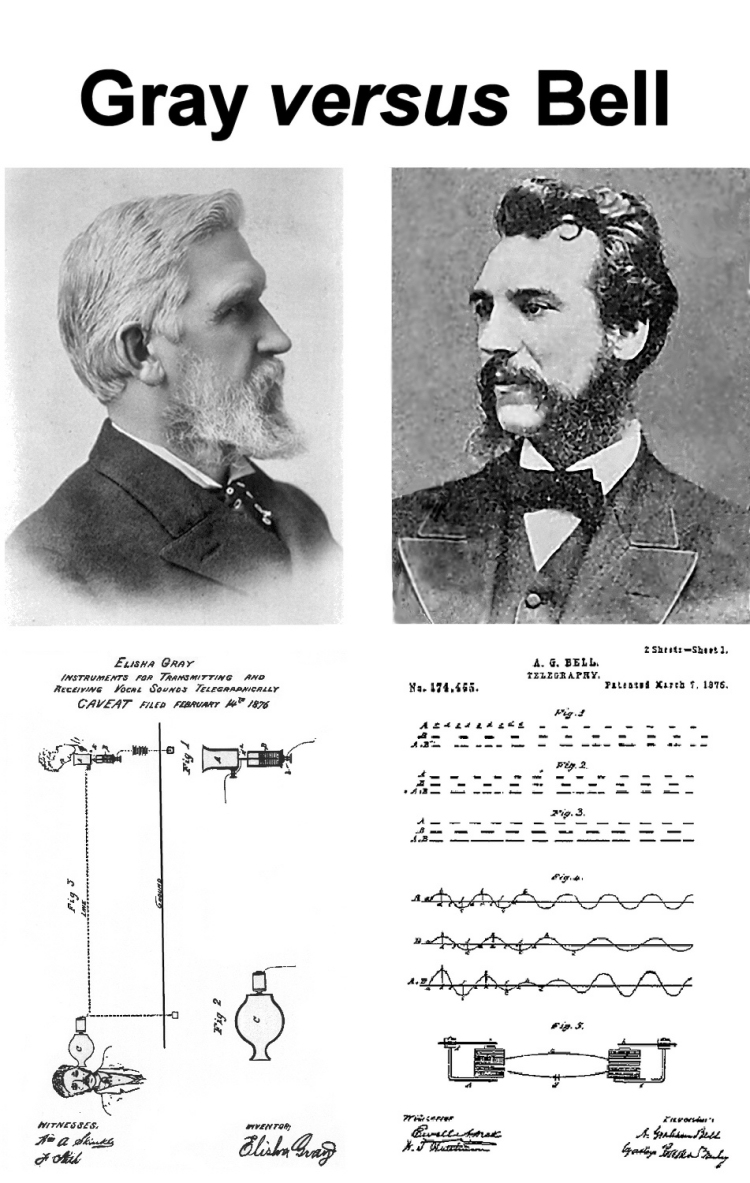
Fig. 2. Bell versus Gray. Elisha Gray (in later years) and Alexander Graham Bell (in the late 1870s). Beneath Gray is his caveat, beneath Bell is his original patent.
It’s rather amusing that many historians have called this so-called Telephone Patent “the most valuable in history.” In a legal and financial sense it was. But nearly all of the patent has nothing to do with telephony—in fact, the word “telephone” isn’t even mentioned in it. Its title, “Improvement in Telegraphy,” belies the fact that it mostly describes an attempt to conceive of a harmonic telegraph that might be capable of transmitting many simultaneous messages on a single wire. As it happens, Bell’s design for a harmonic telegraph could never handle more than three telegraphic signals at a time.
Even more important, the exact construction of the telephone described in Figure 7 of Bell’s patent, with its magneto-electric design having an armature connected by a clumsy hinge pin to the frame of an electromagnet—didn’t really work (in his next model he would glue a metal disk to a parchment diaphram). Bell had essentially patented a nonworking invention, and the Patent Office went along with it.
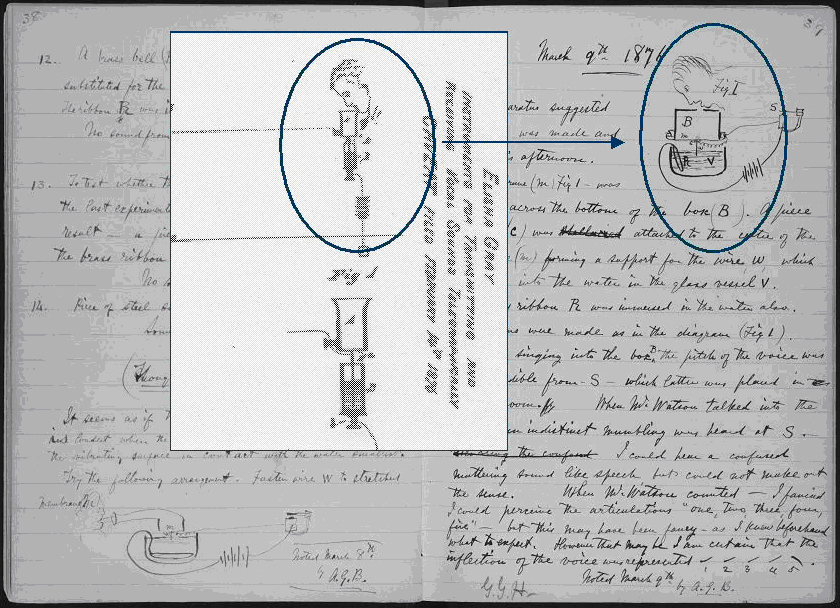
Fig. 3. In the highlighted box one can see an excerpt from Elisha Gray's patent caveat of February 14. One the right is Alexander Graham Bell's lab notebook entry of March 8. Are they suspiciously similar? Did Bell bribe a Patent Officer so he could take a peek at Gray's caveat and then modify his own patent?
But remember that Bell was allowed by Patent Examiner Wilber to mention a second method of transmission in his application: varying resistance in a circuit. Although Bell himself had made no experiments with variable resistance prior to his patent application, just three days after his patent was issued, on March 10, 1976, Bell made his famous first telephone call to Thomas Watson with a device utilizing Gray’s concept of a variable resistance transmitter based on water (ironically, although Gray’s theory was correct, Gray himself had not yet demonstrated a telephone using this principle, and wouldn’t for several months).
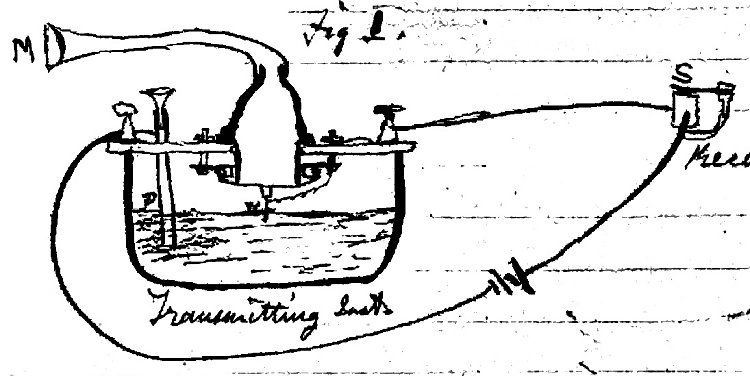
Fig. 4. Alexander Graham Bell’s fateful entry on pages 40-41 of his lab notebook for March 10, 1876. Beneath this drawing, Bell writes, “I then shouted into M [the mouthpiece] the following sentence: ‘Mr. Watson—come here—I want to see you.’ To my delight he came and declared that he had heard and understood what I said.” This occurred in his lab on the rented top floor of a Boston boarding house at 109 Court Street, Boston, Massachusetts.
Here’s how it worked: The user talked into a funnel-shaped mouthpiece, at the base of which was a stretched membrane diaphragm. A metal pin through the center of the diaphragm extended down into the metal cup filled with water and a little sulfuric acid. A fixed resistance exists as an applied current flows from the pin, through the water, to the cup, and thence to the telephone line. Sound waves impinging on the diaphragm would make the needle undulate up and down in the fluid, changing the distance the current had to flow and creating a variable resistance (and thus a smoothly varying electrical current) in response to the speech vibrations. Connect the wires from the pin and cup in series with a battery and a telephone receiver, and you have a crude telephone system.
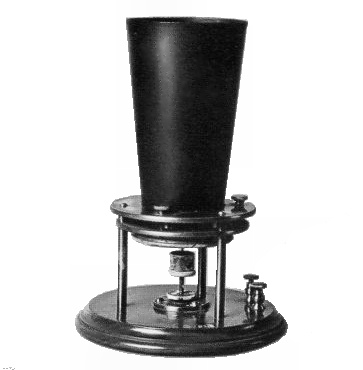
Fig. 5. In the photo at left is Alexander Graham Bell’s liquid transmitter, possibly inspired by the work of Elisha Gray, was used in the first truly successful telephone communication between Bell and Thomas Watson on March 10, 1876.
To his dying day, Gray thought he had essentially “invented Bell’s telephone for him.”
Of course you couldn’t move such a water-filled phone without a spill or interrupting the mechanism, and the water itself would eventually evaporate. The liquid pool transmitter was soon replaced by Bell with an electromagnet-based system (built mostly by Thomas Watson) that used a funnel, metal diaphragm and a permanent magnet.
Bell used this design for his first major public demonstration of the telephone at the 1876 Centennial Exposition. It caused quite a sensation, amazing such luminaries as the Emperor of Brazil, John Henry and William Thomson (Lord Kelvin). Describing the event in his 1887 book, Our Great Benefactors, Samuel Adams Drake wrote: “Had the Sphinx opened its granite lips, surprise could hardly have been greater or more genuine. . . Indeed, it was one of those amazing discoveries that, had it occurred in the days of the Inquisition, would have brought the inventor under suspicion of dealing in sorcery.” Historians now refer to the device as Bell’s Centennial Telephone.
The Centennial model is basically a more refined model of the Gallows Model. Bell was now using an iron disk glued to a parchment drumhead-like diaphram (instead of the previous fixed armature), which gave better results. The fact that he was still using parchment, however, meant that the diaphram could easily soak up moisture (whether from the air or one's breath), causing it to lose tension and go limp.
Still it worked well enough to cause the Emperor of Brazil to exclaim, "My God, it talks!" and one of the exposition's judges, Sir William Thomson (later Lord Kelvin) called Bell's invention "the most wonderful thing in America."
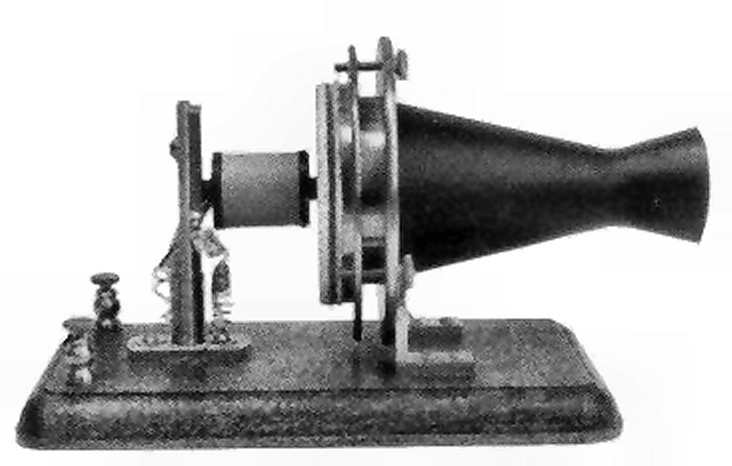
Fig. 6. Bell’s Centennial Model (shown at right) was used publically on June 25, 1976 at the Centennial Exposition in Philadelphia.
By this time Bell had also changed the receiver part of his telephone to an electromagnetic metal diaphragm of the kind used by Gray.
Bell’s first commercial telephone set of 1877 was known as the Box Telephone, since it indeed was a nondescript, awkward wooden box. Within the box was a rectangular version of a device described in Bell’s second telephone patent of January 1877. It had a small funnel-like opening on one side that functioned as both a receiver and transmitter—one spoke into the opening and then listened through the same orifice for a response.
Although these were called “magneto transmitters” they were really just receivers that did double duty as transmitters.
Why? Bell didn’t want to power his phone system with batteries (it costs money to maintain them and replace them after a while), so he thought these Box Telephones could be powered simply by talking loud enough into them. As one could expect, they were good receivers but bad transmitters. Furthermore, performance was further compromised because box phones were connected in series on a line and employed a ground electrical return. When the first experimental line was installed in April 1877 between a Box Telephone in Charles William’s electrical shop on Court Street, Boston and another in his home about three miles away, users had to literally shout into the devices to be heard at all. Bell and his associates realized that they needed a better way of converting or “transducing” sound waves into electrical ones.
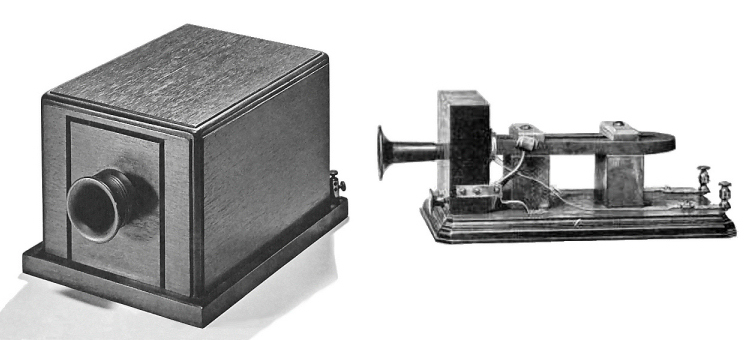
Fig. 7. Bell’s ungainly Box Telephone of 1877. Interior workings are shown at left. There was no device yet such as a bell or buzzer to get the person’s attention at the receiving end of the line. Callers would tap a pencil against the diaphragm or just yell. Using this bulky phone was also a disagreeable affair: you had to pick it up and yell into it, then move it to your ear to listen.
In spite of these problems, Bell and his group decided to fully commercialize the invention. On July 9, 1877, Bell, Gardiner Greene Hubbard, Thomas Watson and Thomas Sanders filed papers to form the Bell Telephone Company (becoming effective on August 1st—the company later reorganized as a corporation in July 1878).
Bell even took some time off. On July 11, 1877 he married Mabel Hubbard, one of his deaf students and daughter of one of his partners, Gardiner Greene Hubbard. At that time 778 telephones were already in use.
While the Bells were away on their honeymoon, Hubbard attempted to sell all the Bell patents to Western Union for $100,000 (about $1,660,000 in 2001 dollars). But the telegraph company thought the device was useless and turned down the offer—undoubtedly one of the worst business decisions of all time.
Bell continued to perfect his invention. When the first telephone exchange was founded in New Haven, Connecticut, on February 28, 1878, subscribers used the “new and improved” Butterstamp telephone, named after a kitchen and restaurant gadget at the time, used to press a decorative pattern into a pat of butter. Each "butterstamp" component is about 6 inches long and about 3 inches in diameter. Inside one can find a bar magnet, a small coil of wire, and an iron diaphragm. Existing specimens of the butterstamp phone still work today.
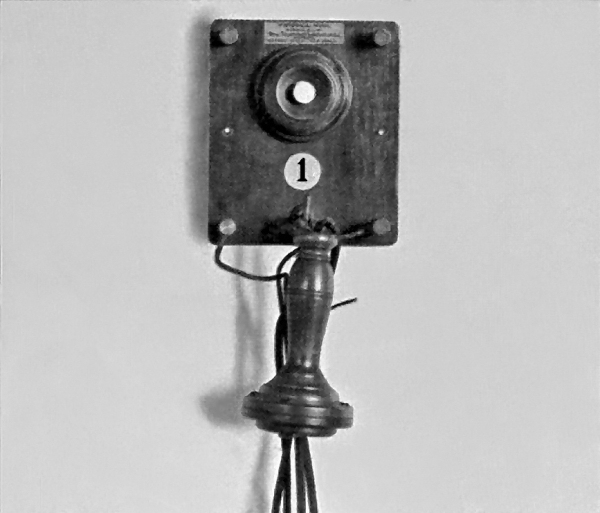
Fig. 8. The first telephone exchange subscribers in 1878 used Bell’s Butterstamp phone, seen in the photo at right. Originally designed in 1877, it combined a combination receiver-transmitter that could be held in one hand. The pushbutton signaled the operator with a “thumper” that tapped on the diaphragm housing of the sending phone, producing a tapping sound at the receiving phone.
Later the same year, the Butterstamp was replaced with the “Coffin Telephone” (yes its cabinet does look somewhat like a coffin).
Built for Bell by the Charles Williams Electrical Shop where Bell and Watson had conducted many of their experiments, the early Coffin Telephone was still essentially a Butterstamp transmitter / receiver but with a hand crank-driven magneto generator that could send extra alternating current over the line to power a ringing device with two bells located either at a direct connected phone or at a central office (see Switches), to alert an operator. (Watson filed for the ringer patent on August 1, 1878.)
The Bell engineers were still not masters of ergonomic design—the crank protruded through the front of the telephone instead of being mounted on the side.
Moreover, moving the Butterstamp component back and forth between the mouth and ear proved too confusing for uncoordinated people, so, by the beginning of 1879, two butterstamps—one for sending and one for receiving—were used in the Coffin Telephone, which now measured 12 inches long and 6 inches wide and was generally made of walnut.
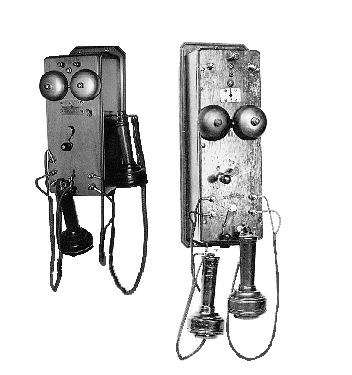
Fig. 9. At right are two examples of Bell’s so-called Coffin Telephone of late 1878 and 1879. Note the two Butterstamp receivers, and the crank on the front to drive a little magneto generator to power the ringing device.
The transmitter of the Coffin phone was still faint. Five Boston banks had ordered Bell telephones and, after the novelty of the invention diminished, they immediately complained about the sound volume, or lack of it.
Seeing an opportunity to compete with Bell with an improved telephonic device, Thomas Alva Edison jumped into the fray. Edison had already begun experimenting with the telephone concept in July of 1876. On March 22, 1877 he signed an Agreement with Western Union for financial support of the Menlo Park laboratory in exchange for all of Edison’s future telegraph and telephone patents (these would later be re-negotiated).
Edison knew that pressing two conductors together reduced electrical resistance between them. This was particularly true of carbon, which exhibits a great deal of variation in resistance under pressure and for this reason is still used in telephone transmitters.
After the incredibly methodical, exhaustive experimentation for which he was famous, he settled on what is now known as the “button” transmitter. One early version of this contained a metallic diaphragm fastened to the iron case of an iron cap into which was screwed an ebonite mouthpiece. This formed a vibrating cover over a chamber with ebonite sides. In this chamber was a button of pressed lampblack or processed anthracite coal granules, sandwiched between two platinum plates, each of which were connected to the electrical circuit. Attached to the center of the metallic diaphragm was a small piece of rubber tubing that pressed lightly against an ivory piece placed directly over one of the platinum plates. Sound waves hitting the diaphragm produced varying pressure on the carbon, thus producing corresponding variations in the circuit’s resistance.
Whereas Bell’s transmitter depended upon the human voice to generate electric signals, Edison’s transmitter simply used the human voice to modulate a more powerful electric current. Edison also passed his signals through the primary winding of an induction coil, the secondary coil of which was able to produce analogous impulses of higher potential for transmission along the wire to the receiver, thus increasing its range tremendously. Edison’s first test of his new transmitter was over a 106 mile line between New York and Philadelphia; it was a success and he filed for a patent on April 27, 1877 (amazingly, because of brilliant legal complications concocted by the Bell company, the patent, No. 474,230, wouldn’t be issued until May 3, 1892).
Edison’s “button” transmitter produced a more powerful electrical signal than Bell’s magneto type transmitter, yielding greater volume, crystal-clear transmission of vocal inflection, and an improved distinction between vowel sounds and consonants. Western Union recognized this immediately and soon wanted to use it to compete with Bell in the telephone business. However, Bell’s company still had a better receiver than Western Union’s.
Edison remedied the Western Union’s receiver problem with his bizarre, ingenious “chalk receiver.” It had no magnet, simply a diaphragm made of mica and a cylinder of compressed chalk about the size of a thimble. The chalk was moistened with a chemical solution and was revolved either by the user turning a crank or by a small electric motor. Connected to the center of the receiving diaphragm was a palladium-faced pen or thin spring that extended inward and rested on the chalk cylinder, pressing against it with a pressure of about six pounds. The varying electrical current from the distant telephone transmitter came over the telephone line, was passed through the spring to the chalk and then to the battery. The varying electrical current emerging from the distant transmitter caused an equivalent variation in friction between the spring and the chalk, and this in turn produced vibrations of the diaphragm which reconstructed the sounds made into the transmitter.
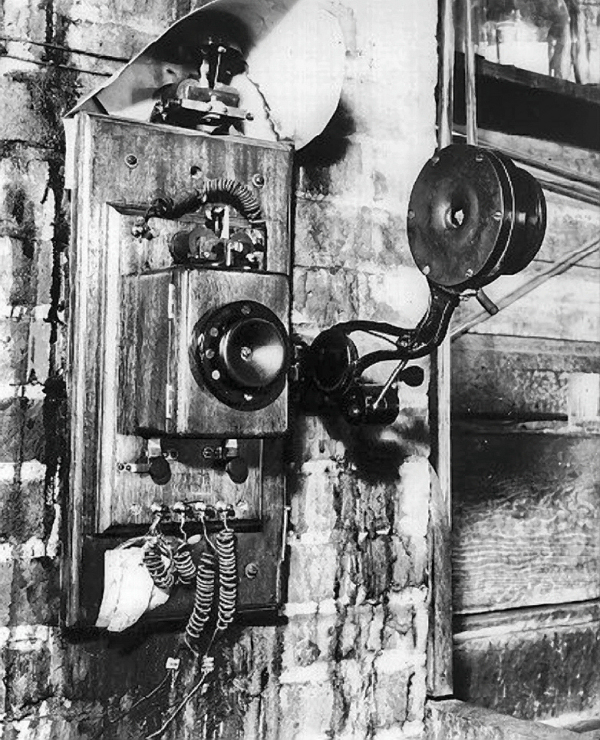
Fig. 10. At right: Edison’s phone having a carbon transmitter and chalk receiver, restored and on display at the reconstructed Menlo Park Laboratory in Dearborn, Michigan.
Edison’s new chalk receiver not only avoided any interference with the Bell patent (he was issued patent 221,957 for it on November 25, 1879) but reception with it was much louder than Bell’s device. Indeed, many people considered the chalk receiver much too loud. In one experiment, a man talking into a carbon transmitter in New York City had his voice so amplified by the chalk receiver that he could be heard 1,000 feet away in an open field near Edison’s lab in Menlo Park, New Jersey. In another demonstration, “spoken words and the singing of songs originating at a distance” were heard perfectly by an audience of over 5,000 people.
This incredible loudness was possible because the power was provided by the user turning a handle instead of relying on the meager energy provided by the human voice itself, as Bell’s system did. In Edison’s system, the voice merely controlled or modulated a greater power, “just as an engineer working a valve would control a powerful engine,” as Edison described it.
It was with some understated humor, then, that Edison’s receiver became known as “the loud-speaking phone.”
On November 17, 1877, Western Union decided to challenge Bell’s monopoly in the telephone business, and established both the American Speaking Telephone Co. and the Gold & Stock Telephone Company to combine its interest in Edison’s transmitter patents with Elisha Gray’s receiver patents, now owned by the Harmonic Telegraph Company. Western Union was a huge company at the time and began to deploy telephone systems throughout the world. In theory, the small Bell Company didn’t have a chance.
On September 12, 1878, the Bell Telephone company filed suit against Peter A. Dowd, head of the American Speaking Telephone Company, claiming that the technology of Edison and Gray were infringing on the Bell patents.
To keep Western Union from stealing all of their business during the ensuing legal battle, Bell needed a better transmitter to compete in the marketplace.
In 1877 Emile Berliner (1851-1929) also devised a telephone transmitter, one based on the principle of pressure-induced variable resistance between two metals. He filed a caveat at the U.S. Patent Office on April 4, 1877, and then approached the Bell Company, initially wanting $12,000 for the invention.
On January 22, 1878, one of Bell’s attorneys wrote a letter to Berliner that read in part, “I do not suppose that you seriously believe that your invention is worth $12,000 at the present time.”
But Western Union was gaining on Bell, and in September of 1878 the Bell Telephone Company found itself paying Berliner a reported $50,000 (the equivalent of $877,000 in 2001 U.S. dollars) for the rights to his patent, plus giving him the position of chief engineer. This transmitter telephone was initially known as the “Bell-Berliner Telephone.”
Berliner’s caveat, describing the concept of variable electrical resistance resulting from variable pressure, had been filed on April 4, 1877, just before Edison’s carbon transmitter patent application of April 27, 1877. This enabled the Bell company in September 1878 to file an “interference” against Edison’s variable pressure/variable resistance carbon transmitter—and then to use a carbon transmitter of its own design without being immediately stopped by the courts. This clever legal move made it possible for Bell to acquire rights to a new carbon transmitter—all they needed now was the transmitter!
Fortunately, in 1878, Professor David Edward Hughes (1831-1900) invented one of the early versions of the carbon microphone. He discovered that a carbon rod allowed for a loose electrical contact against a diaphragm, which enables production of undulating currents closely matching the sound waves of the human voice (both Hughes and Berliner used the term “microphone” to distinguish their transmitters). Francis Blake, Jr. (1850-1913), of Weston, Massachusetts, a mathematical prodigy, photographer, and former officer in the U.S. Coast Survey, was inspired by Professor Hughes’ experiments and spent the summer of 1878 developing a transmitter relying on a varying contact between a metal diaphragm and a carbon block, which he also offered to Bell as a rival to Edison’s transmitter. The Bell Company gave Blake some stock for the rights to the carbon transmitter and began to use it in December 1878.
Blake spent the summer of 1878 experimenting with a telephone transmitter. Before the year was out, he had invented “the Blake Transmitter” and sold it to Bell for stock in the telephone company.
Both the Berliner and Blake transmitters had their advantages, so Bell had Berliner combine their best attributes into a “Berliner-Blake” transmitter that was used in telephones until the mid 1890s in the U.S. and until the early 1900s in places such as Great Britain. Berliner also added induction coils to the telephones, further improving transmission, though Western Union claimed that this infringed on Edison’s prior use of induction coils in his transmitter.
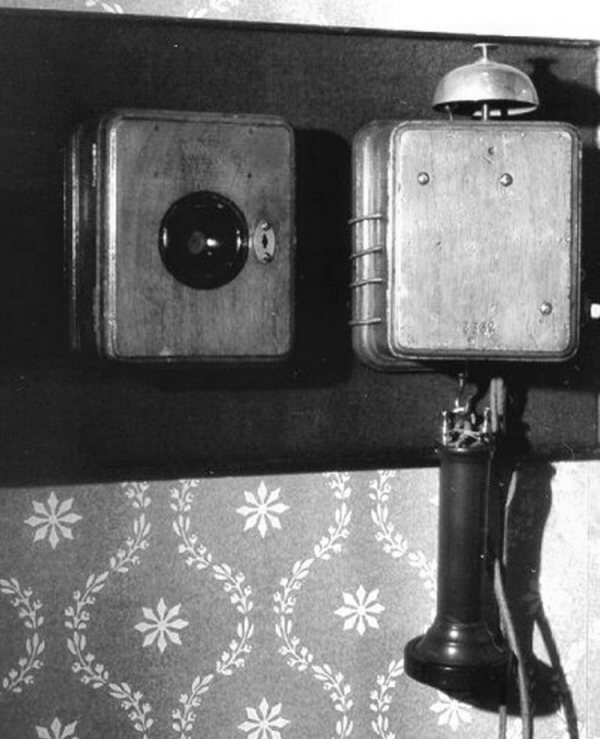
Fig. 11. A Bell Telephone from 1879. The “Butterstamp” receiver is at right, but the separate microphone in its own box is the Blake transmitter, which became part of Bell telephones in 1878 and was improved by Emile Berliner. With one plate of metal and another of carbon, vocal sound vibrations caused changes in pressure that changed the microphone’s electrical resistance, thus varying the current. The Blake transmitter was used on Bell’s telephones until usurped by Anthony White’s solid-back transmitter, following a patent exchange with Western Electric and Thomas Edison.
Armed with new technology, Bell and his company recapitalized and reorganized on February 17, 1879 as the National Bell Telephone Company. Demand for phones was skyrocketing, and, in addition to the first production facility in what was a machine shop in Boston owned by Charles Williams, Bell licensed five companies to manufacture telephone instruments and switchboards under the supervision of Thomas A. Watson.
Western Union, now cognizant of the fact that they couldn’t easily steal Bell’s market and at the same time fearful that the courts would uphold his patents, now decided to negotiate with their stubborn, resourceful rival.
In a famous settlement agreement of November 10, 1879, Western Union agreed to declare Alexander Graham Bell the true inventor of the telephone, selling its 56,000 existing telephones to National Bell and withdrawing from the telephone business for the life of the Bell patents. National Bell agreed to pay Western Union 20% of all royalties earned under its telephone licensing contracts for the duration of the Bell patents. National Bell also paid several thousand dollars in cash for rights to the patents Western Union held on Thomas Edison’s carbon transmitter and other telephone-related technology, such as Elisha Gray’s. Western Union further received 40% of the stock of the local telephone systems in New York City and Chicago. In return, Bell agreed to stay out of the telegraph business.
After the court battle was over, Bell decided to phase out the Blake-Berliner transmitter and replace it with Edison’s superior button transmitter technology. But before that happened, the ideas of Edison, Blake and Berliner were further improved by Bell engineer Anthony C. White in 1892. In White’s transmitter, two carbon button electrodes were placed in contact. One was fixed and the other (in front) was attached to a diaphragm consisting of a mica disk. Loose carbon granules sat between the two. Sound vibrations moved the mica disk back and forth like a piston, jostling the carbon particles around and rapidly varying the resistance of the circuit. This “solid back” transmitter was the most reliable yet devised and was used from 1892 until about 1925.
Ironically, the idea of using carbon granules had originated much earlier. In September 1878 a carbon transmitter was patented by an English clergyman, the Rev. Henry Hunnings (1834-1887) of Bolton Percy, Yorkshire. Hunnings’ transmitter relied on multiple loose contacts in the form of loosely compacted granules of coke that vibrated between two electrodes consisting of a diaphragm and a metal backplate. Hunnings early device had a problem where the carbon particles would “pack” or stick together, reducing their efficiency in transducing the voice. Still, the Hunnings-White technology ultimately replaced Blake’s as the Bell Companies’ standard transmitter, though Edison enjoys historical credit as the inventor of the telephone’s carbon microphone.
The legendary businessman Theodore N. Vail (1845-1920) was then brought on board, who originated the idea of expanding the Bell System into a vertically integrated “natural” monopoly.
On February 20, 1880 Bell formed a new entity, the American Bell Telephone Company, and on April 17, 1880 National Bell’s operations officially became the American Bell’s. On November 26, 1881, American Bell took a controlling interest in the Western Electric Manufacturing Co., merging it with Bell’s own Boston manufacturing plant and reorganizing it as the Western Electric Company, which made its debut on February 6, 1882. Western Electric was now the sole supplier of telephones and telephone equipment to the Bell System—the license contracts of the five original telephone manufacturers were now assigned to Western Electric. (The company refused to renew the contracts when they expired.) Elisha Gray’s and Enos Barton’s little company ultimately became one of the largest electrical manufacturing concerns in the world.
While Gray may have missed receiving the accolade of “inventor of the telephone,” he did make a great deal of money off of his other 70 patents. And, in 1880, he became professor of dynamic electricity at Oberlin College, in Oberlin, Ohio.
Gray died of a heart attack in Newtonville, Massachusetts in 1901. Shortly thereafter, a note was found among his personal effects that is perhaps the most wry of all commentary on the birth of the telephone. It read, in part, “The history of the telephone will never be fully written.... It is partly hidden away, and partly lying on the hearts and consciences of a few whose lips are sealed—some in death and others by a golden clasp whose grip is even tighter.”
Both the name of Elisha Gray and his partner Enos Barton live on. In 1925 Western Electric decided to spin off its thriving distribution business in non-telephone electrical products made by other manufacturers. The names of the founders, Gray and Barton, were combined to form the new company’s name—the Graybar Electric Company, Inc.—which today is a huge international distributor of approximately a million electrical and communications and data products, and enjoys $5 billion in annual sales.
In 1885, the American Telephone & Telegraph Company (AT&T) was incorporated in New York State to handle American Bell’s long distance service. Long distance was priced higher than local service; and by the 1890s the parent company of the local Bell operating companies was struggling, while the long distance subsidiary was thriving. The solution was to have the subsidiary become the parent. So, in 1899, AT&T was made the parent company, absorbing American Bell. AT&T and the Bell System would almost completely dominate American telecommunications until January 1, 1984. On that date, bowing to anti-monopoly pressure by the Justice Department and the courts, the Bell System was divested into seven regional “Baby Bell” companies (providing local service) and a more diminutive AT&T to handle long distance service. (Western Electric remained with AT&T and was renamed AT&T Technologies).•
